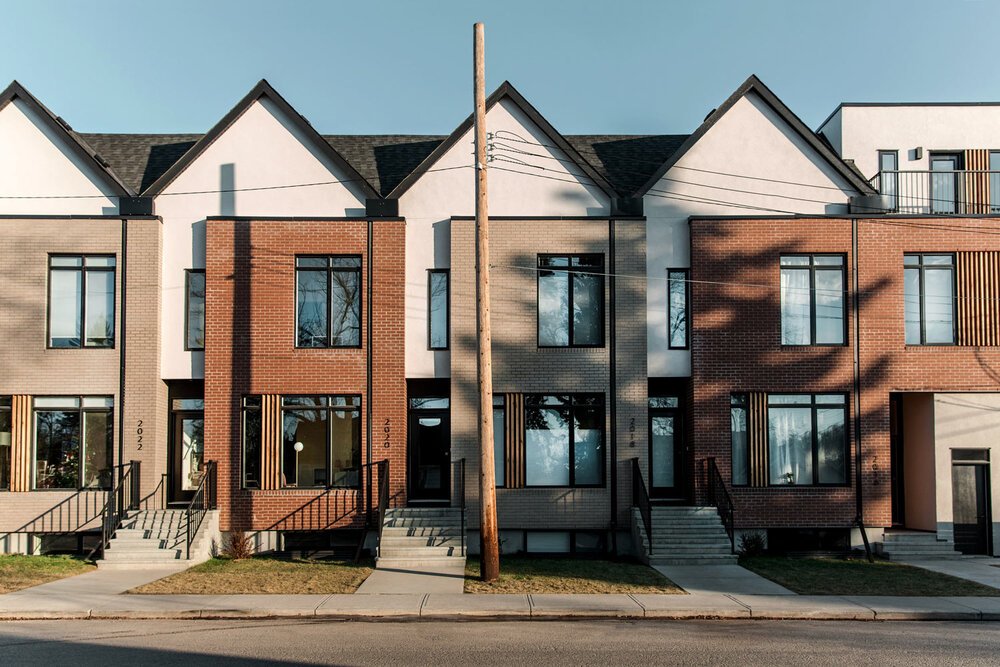
Rezoning for Housing
Incremental zoning changes are crucial to abundant and affordable housing. Find out why More Neighbours supports incorporating R-CG housing into the base zone.
What is R-CG and why should I care?
On April 22, Calgary City Council will hold a public hearing on a proposal to make it legal to build more homes throughout our city. This is a good thing. Scroll down to find out why, and how you can support this important change.
Why does Calgary need zoning reform?
Zoning is just a set of rules about what can be built where. Calgary’s residential zoning code is highly restrictive and is preventing us from being able to respond to changing demographics, housing needs, and population growth.
Currently, more than 60% of Calgary’s land is zoned for single-detached homes only (one-standalone house per lot). Another 20% permit up to two units. In most neighbourhoods it is very difficult to build anything other than a detached or semi-detached house. Because of this, Calgary has grown out rather than up for decades, and created a legacy of inefficient and expensive sprawl.
The City of Calgary has developed a policy called Rezoning for Housing that will allow more and more diverse types of housing to be built throughout the city, using a zoning type called R-CG.
R-CG zoning: Tried and tested incremental change
R-CG is a type of zoning that allows for more flexibility in residential neighbourhoods. It stands for:
Residential (no commercial or industrial uses permitted)
Contextual (in height and lot coverage)
Ground oriented (no apartment buildings permitted)
R-CG zoning has been around for a decade, though due to zoning restrictions there are few neighbourhoods in which it can currently be built. The most typical examples of R-CG housing are fourplex-style rowhomes, common in neighbourhoods like Altadore and Capitol Hill. Sometimes they have basement suites for a total of eight units. They fit into existing neighbourhoods without towering over other infill housing, and have slightly larger lot coverage.
Rowhouses aren’t the only configuration for R-CG. The zoning allows a single-detached home to have both a basement suite and a laneway home. This can be a great solution for many homeowners who want to create space for extended family, or bring in some extra income.
Why is R-CG in the news right now?
Calgary’s current base zoning district allows a single-detached home to be built by right on nearly any residential property in the city. The City of Calgary is proposing to change the base district to allow R-CG housing to be built by right throughout the city. Right now, most R-CG projects have to go through a land-use redesignation process that can take 9-12 months and tens of thousands of dollars. These layers of red tape make R-CG homes difficult to build.
R-CG is not a silver bullet solution or quick fix to our housing crisis; It is however a step in the right direction, and an effective tool for adding more supply, at a more affordable price point. Housing is a complex and multi-faceted problem, but there are no set of solutions that don’t involve adding a lot more homes. Right now, our exclusionary zoning code is holding us back.
Read our official letter of support.
Here’s why we support this change:
Zoning reform is fiscally responsible
Our sprawling low-density building patterns are expensive. It costs far more to create infrastructure to service edge communities than to add more people to our existing footprint. Many of our established neighbourhoods are well below peak population and thus the infrastructure is underutilized.
Zoning reform can help keep our tax dollars low and make service delivery easier. A more responsive housing market can make it easier to attract talent to the city
Zoning reform is climate action
The biggest source of carbon emissions in our city are from buildings and vehicles. Homes that are smaller and share walls require less energy to build and heat. Homes closer to the city centre require fewer car trips, and make it easier to get around on foot, bicycle, or transit. Adding housing means adding people who can support local amenities and small businesses in their neighbourhood, as well as provide the population base for a more sustainable transit system.
Focusing growth in our existing city footprint allows us to preserve the natural biodiversity of the areas outside our city that are at risk from greenfield development. Read about Ricardo Ranch and what we stand to lose if we keep sprawling outward.
Zoning reform is a social issue
According to Calgary’s Housing Needs Assessment, one in five households cannot afford their housing.
When housing is scarce, people suffer. Calgary’s housing shortage and skyrocketing rents are affecting peoples lives and livelihoods. High housing costs can prevent people from pursuing educational or employment opportunities in our city; young people live with their parents into adulthood and delay forming families.
But these are the lucky ones. Many people priced out of the housing market resort to living in cramped or substandard living arrangements. Others find themselves without anywhere to go: Calgary’s homeless shelters are seeing record demand, including from many first-time clients.
There are no solutions to our housing crisis that don’t include adding a lot more homes, and we simply can’t add these homes without addressing our highly-restrictive zoning code.
I want to support this change!
What can I do?
-
Send your councillor an e-mail expressing your support. You can write a detailed policy brief with many footnotes, or simply drop them a line to say you think the change is good and you support it.
Calgary’s Future has created a helpful e-mail tool. -
Any Calgarian who cares about this issue can share their views with City Council in a public hearing the week of April 22. Click here for instructions on how to sign up to speak. You don’t have to be a great orator, just tell your story.






